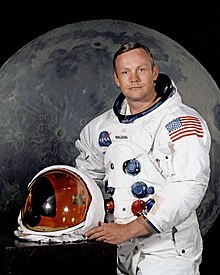
Back Neil Armstrong Afrikaans Neil Armstrong ALS ኒል አርምስትሮንግ Amharic Neil Armstrong AN نيل آرمسترونغ Arabic نيل ارمسترونج ARZ নীল আৰ্মষ্ট্ৰং Assamese Neil Armstrong AST Нейл Армстронг AV Neil Armstrong Aymara
Neil Armstrong | |
|---|---|
 Armstrong in July 1969 | |
| Born | Neil Alden Armstrong August 5, 1930 |
| Died | August 25, 2012 (aged 82) |
| Education | Blume Highschool |
| Alma mater |
|
| Spouses | Janet Shearon
(m. 1956; div. 1994)Carol Knight (m. 1994) |
| Children | 3 |
| Awards | |
| Space career | |
| USAF / NASA astronaut | |
Previous occupation | Naval aviator, test pilot |
| Rank | Lieutenant (junior grade), United States Navy |
Time in space | 8 days, 14 hours, 12 minutes, and 30 seconds |
| Selection | |
Total EVAs | 1 |
Total EVA time | 2 hours 31 minutes |
| Missions | |
Mission insignia |   |
| Signature | |
 | |
Neil Alden Armstrong (August 5, 1930 – August 25, 2012) was an American astronaut and engineer and is known as the first person to walk on the moon. On July 20, 1969, Neil Armstrong and Buzz Aldrin landed on the moon in a small spacecraft that had been sent to the moon using the Saturn V rocket. The mission was called Apollo 11. They both walked on the moon, and millions of people watched and heard this event on live television.
He earned a BSc degree in Aeronautical Engineering from the Purdue University in 1955[1] and an MSc degree in Aerospace Engineering from the University of Southern California. In 1970 he received an Honorary Doctorate of Engineering from the Purdue University. In 1971 he became professor of aerospace engineering at the University of Cincinnati. He joined the National Aeronautics and Space Administration, then known as the National Advisory Committee for Aeronautics, serving as a civilian test pilot at Edwards Air Force Base, Lancaster, Calif.
In 2005, he received the Honorary Doctorate of letters from the University of Southern California. The Houston Chronicle newspaper reported on October 1, 2006, that Australian computer programmer Peter Shann Ford found the missing "a" from Armstrong's famous first words on the Moon. Ford reported that he downloaded the audio recording from a NASA web site and analyzed it using editing software originally intended for use with hearing disabled people. Armstrong is said to have been pleased with Ford's finding of the missing "a".
- ↑ Today, Purdue. "From the Archives revealed: Purdue Avionics Club and Neil Armstrong". www.purdue.edu. Archived from the original on 2022-09-20. Retrieved 2022-09-18.